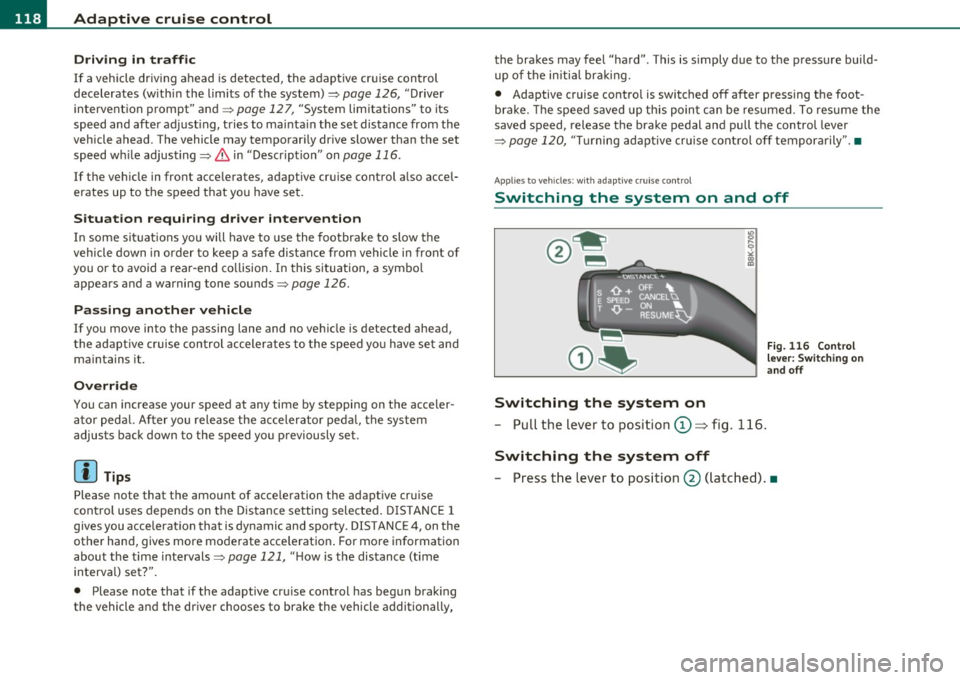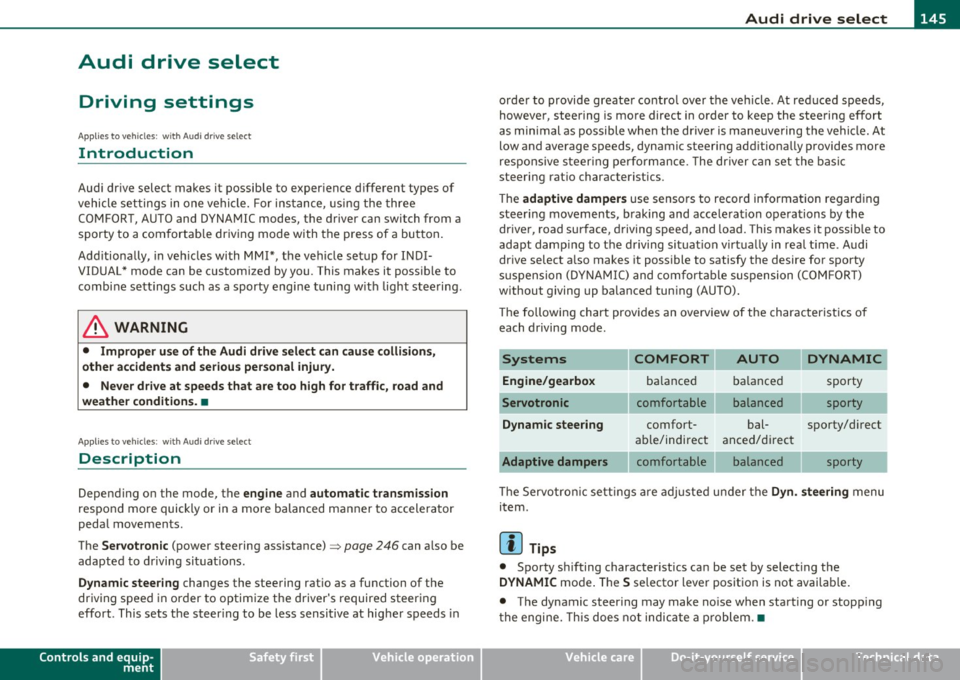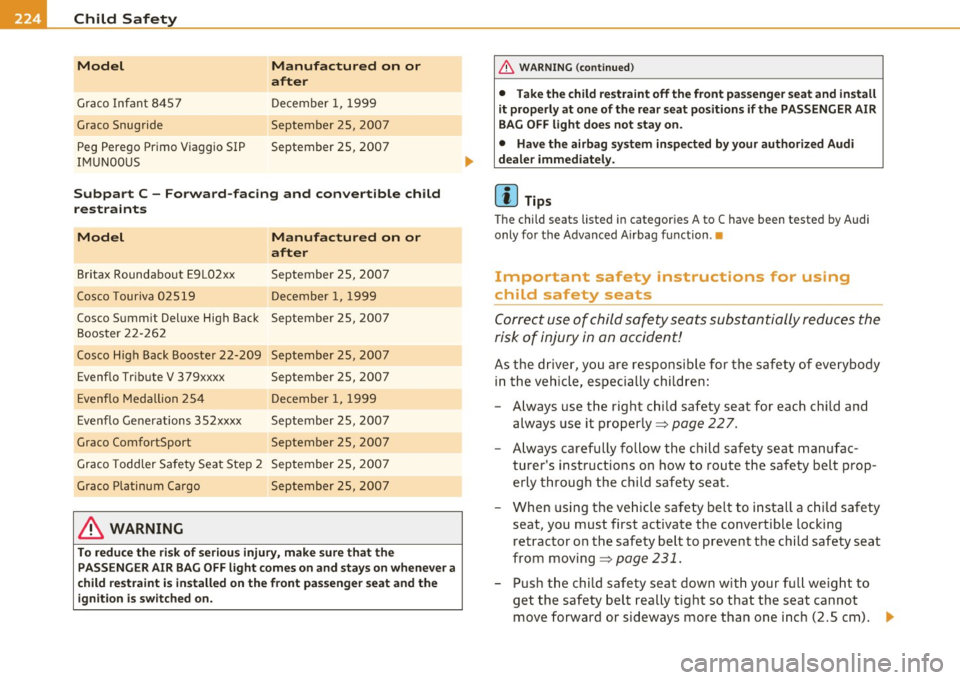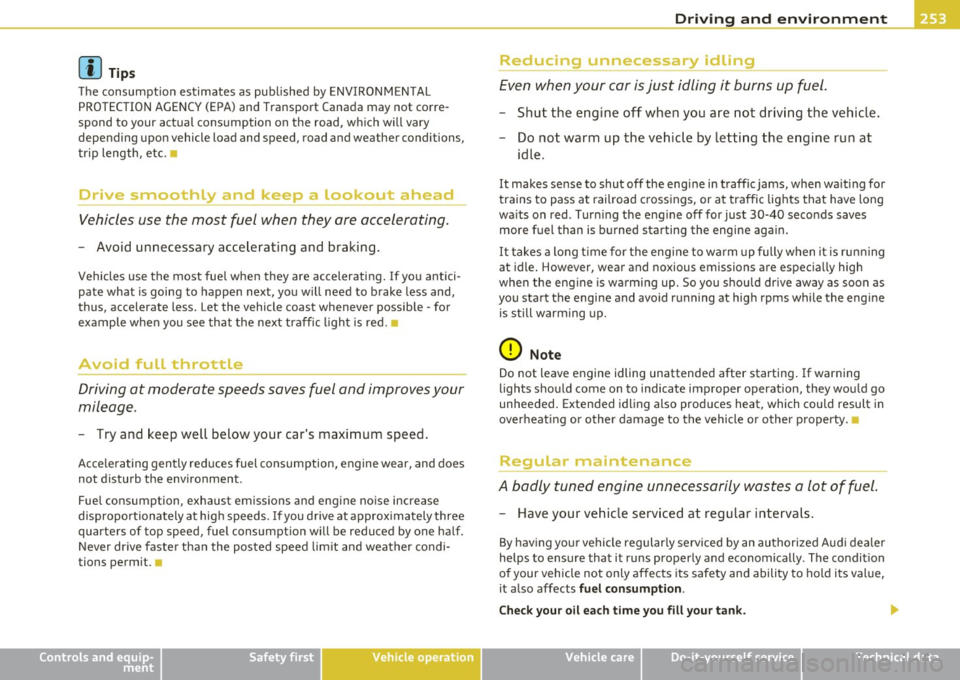sport mode AUDI A5 CABRIOLET 2011 Owners Manual
[x] Cancel search | Manufacturer: AUDI, Model Year: 2011, Model line: A5 CABRIOLET, Model: AUDI A5 CABRIOLET 2011Pages: 364, PDF Size: 86.48 MB
Page 120 of 364

lffll.___A_ d_ a,.:.p _ t_ i _v _ e_ c_ r _u _ is_ e_ c_o _n_ t_r _o _l _____________________________________________ _
Driving in traffic
If a vehicle driving ahead is detected, the adaptive cruise control
decelerates (within the limits of the system)=>
page 126, "Driver
intervention prompt" and=>
page 127, "System limitations" to its
speed and after adjusting, tries to mainta in the set distance from the
vehicle ahead. The vehicle may temporarily drive slower than the set
speed wh ile adjusting::::>
& in "Description" on page 116 .
If the vehicle in front accelerates, adaptive cruise control also accel
erates up to the speed that you have set.
Situation requiring driver intervention
In some situations you will have to use the footbrake to slow the
vehicle down in order to keep a safe distance from vehicle in front of
you o r to avoid a rear-end co llision. In this situation, a symbo l
appears and a warning tone sounds=>
page 126.
Passing another vehicle
If you move into the passing lane and no vehicle is detected ahead,
the adaptive cruise control accelerates to the speed you have set and
maintains it .
Override
You can increase your speed at any time by stepping on the acceler
ator pedal. After you release the accelerator pedal, the system
adjusts back down to the speed you previously set .
[ i ] Tips
Please note that the amount of acceleration the adaptive cruise
control uses depends on the Distance setting selected. DISTANCE 1
gives you accelerat ion that is dynamic and sporty. DISTANCE 4, on the
other hand, gives more moderate acceleration . For more information
about the time intervals=>
page 121, "H ow is the distance (time
interval) set?".
• Please note that if the adaptive cruise control has begun braking
the vehicle and the driver chooses to brake the vehicle additionally, the brakes may
feel "hard". This is simply due to the pressure build
up of the initial braking.
• Adaptive cruise contro l is switched off after pressing the foot
brake. The speed saved up this point can be resumed. To resume the
saved speed, release the brake pedal and pull the control lever
=>
page 120, "Tu rning adaptive cruise control off temporarily". •
Applies to veh icles : wit h ad aptive c ru is e cont rol
Switching the system on and off
Switching the system on
- Pull the lever to position
0 => fig. 116.
Switching the system off
Fig . 116 Control
lever: Switching on
and off
- Press the lever to position@ (latched) .•
Page 147 of 364

________________________________________________ A_u_ d_i_ d_ r_iv _ e_ s_ e _ le_ c_t __ _
Audi drive select
Driving settings
Applies to veh icles : with Aud i driv e select
Introduction
Audi dr ive select makes it possible to exper ience d ifferent types of
vehicle set tings in one vehi cle. For ins tance, using the three
COMFORT, AUTO and DYNAMIC modes, the driver can switch from a
sporty to a com fortab le dr iv ing mode with the p ress of a bu tton .
Add itionally, in ve hicles with MMI*, the veh icle se tup for I NDI
VIDUAL * mode can be customized by you. This makes it poss ib le to
combi ne sett ings such as a sporty engi ne tuning w it h light stee ring.
& WARNING
• Improper use of the Audi drive select can cause collisions,
other accident s and serious personal injury.
• Never drive at speeds that are too high for traffic , road and
weather conditions. •
Applies to veh icles: wit h Aud i dri ve select
Description
Depending on the mode, the engine and automatic transmission
respond more quickly or in a more balanced ma nner to a ccelera tor
peda l movements.
The
Ser votron ic (power steering assistance)=> page 246 can also be
adapted to d riving situat ions.
Dynamic steering changes the steering rat io as a function of the
driv ing speed in order to op tim ize t he d river's required steer ing
effort . This sets the steer ing to be less sensitive at highe r sp eeds in
Controls and equip
ment Safety first
orde
r to provid e greate r contro l over the ve hicle. At r educ ed spe eds,
howeve r, steering is mo re direct in order to keep the stee ring effort
as minimal as possible whe n the drive r is maneuve ring the vehi cle. At
low and average speeds, dynamic steering add itiona lly p rovides more
responsive steer ing perfo rm ance. The driver can set the basi c
steering rat io characteristics.
Th e
adaptive damper s use sensors to recor d informat ion regar ding
stee rin g movements, b raking and accele ration ope ra tions by the
dr iver, road sur face , d riving speed, and load. This makes it possib le to
adapt damp ing to t he d riving situat ion virt ua lly in rea l time . Audi
dr ive select a lso makes it poss ible to satisfy the desire for sporty
s us pension (DY NAM IC) and comfort able suspension ( COMFOR T)
without giving up balanced tun ing (AUTO).
Th e followi ng chart prov ides an overv iew of t he char acteristics of
each driving mode .
Systems COMFORT AUTO DYNAMIC
Engine/gearbox bala nce d b ala nce d sporty
comfortable balanced sporty
Dynamic steering comfort- bal- sporty/d irect
ab le/indirect
anced/direc t
comfortable balanced sporty
Th e Servo tro nic sett in gs are a djusted und er the
Dyn. steering menu
item .
[I] Tips
• Spo rty sh ifting character istics can be se t by select ing the
DYNAMIC mo de. The S se lector lever posit io n is not avai lab le.
• The dynamic steer ing may make no ise when start ing or stopp ing
t he e ngine. This does no t indic ate a p roblem. •
Vehicle care Technical data
Page 148 of 364

llffl..__A_ u_d_ i _d _r_ i_v _e _ s_e _ l_ e _ c_ t _______________________________________________ _
Applie s to veh icl es : w ith A udi d riv e se lect
Selecting the driving mode
You can choose between COMFORT, AUTO, DYNAMIC and
INDIVIDUAL* modes.
en • 2 ,;
~- =========::::: LP
Fig. 149 Shift gate:
Control for Audi drive
select
Fig . 1S0 Ce nter
console: Control for
Audi drive select
The control is located on the shift gate~ fig. 149 in vehicles
with a radio, and in vehicles with MMI, it is located in the
center console~ fig. 150.
- Turn on the ignition .
- Press the left or right arrow button u ntil the desired mode
appears in red.
You can change the driving mode when the vehicle is stationary or
whil e driving. If traffic permits, after changing modes, briefly take
your foot off the accelerator pedal so that the recently selected mode
is also activated for the eng ine and transmission .
COMFORT
The COMFORT mode provides a comfo rtable vehicle se tting. The
engine and automatic t ransm ission* react in a balanced manner to
movements of the acce leration pedal. Steering is light and indirect,
and adaptive dampe rs provide a soft s uspension . The setting is ideal
for driving on long stretches, such as on freeways .
AUTO
Full use of AUTO provides a comfortable, yet dynamic feel. The
sett ing is perfect for daily use .
DYNAMIC
DYNAMIC gives the vehicle a sporty feeling. The eng ine responds
quickly to accelerator pedal movements, and steering is sporty and
more direct. The adaptive dampers are adjusted to provide a stiffer
suspension, and the automatic transmission* shift points are set at
higher engine speed ranges. The setting is ideal for sporty driving.
INDIVIDUAL*
You can adapt this mode to your personal needs in the MMI.
& WARNING
Pay attention to traffic when operating Audi drive select to
prevent potential risk of an accident .
(I] Tips
If you remove the ignition key, AUTO mode is set the next time you
start the ignition. •
Page 226 of 364

ffl,___C_ h_ il_d _ S_a _ f_ e _ t-= y ;....._ ____________________________________________ _
Model
Graco Infant 8457
Graco Snug ride
Peg Perego Primo Viaggio SIP
IMUN00US
Manufactured on or
after
December 1, 1999
September 25, 2007
September 25, 2007
Subpart C -Fo rward-fa cing and con vertib le child
re straints
Model Manufactured on or
after
Britax Roundabout E9 L02xx September 25, 2007
Cosco Touriva 02519 December 1, 1999
Cosco Summit Deluxe High Back September 25, 2007
Booster 22 -262
Cosco H igh Back Booste r 22-209 September 25, 2007
Evenflo Tr ibute V 379xxxx September 25, 2007
Evenflo Medallion 25 4 December 1, 1999
Evenflo Generations 352xxxx September 25, 2007
Grace ComfortSport September 25, 2007
Grace Toddler Safety Seat Step 2 September 25, 2007
Graco P latinum Ca rgo September 25, 2007
& WARNING
To reduce the ri sk of serio us i njury , make sure th at the
PAS SENGER AIR BAG OFF l ight com es on and s tays on wh en ev e r a
c hild re straint is i nsta lle d on the front pas senge r seat and th e
ign itio n is s witch ed on .
& WAR NING (continu ed)
• Take the child re st raint off the front pa ssenger seat and in stall
i t properly at one of the rear s eat position s if the PASSENGER A IR
BAG OFF light doe s not stay on .
• Hav e the a irb ag sys tem in spect ed by your authori zed Audi
deal er immedi ate ly .
[I) Tips
The chi ld seats listed in categories A to C have been tested by Audi
only for the Advanced A irbag function .•
Important safety instructions for using
child safety seats
Correct use of child safety seats substantially reduces the
risk of injury in an accident!
As the driver, you are responsible for the safety of everybody
in th e veh icle, especially children :
- Always use the right child safety seat for each child and
always use it properly=>
page 22 7.
- Always carefully follow the child safety seat manufac
turer's instructions on how to route the safety belt prop
erly through the child safety seat .
- When using the vehicle safety belt to install a child safety
seat, you must first activate the convert ible locking
retractor on the safety belt to prevent the child safety seat
from movi ng =>
page 231.
- Push the child safety seat down wit h your full weig ht to
get the safety belt really tight so that the seat cannot move forward or sideways more than one inch (2.5 cm). ._
Page 255 of 364

Driving and environm ent
------------------------------------------------'
[I) Tip s
The consumption estimates as published by ENV IRONMEN TA L
PROTECTION AGENCY (EPA) and Transport Canada may not corre
spond to your actual consumption on the road, wh ich w ill vary
depending upon vehicle load and speed, road and weather conditions ,
trip length, etc. •
Drive smoothly :1nd keep a Lookout ahead
Vehicles use the most fuel when they are accelerating .
-Avoid unnecessary accelerating and braking.
Vehicles use the most fuel when they a re accelerating. If you antici
pate what is going to happen next, you will need to brake less and,
thus, accelerate less. Let the vehicle coast whenever possible -for
example when you see that the next traffic l ight is red. •
Avoid full throttle
Driving at moderate speeds saves fuel and improves your
mileage.
- Try and keep well below your car's maximum speed .
Accelerating gently reduces fuel consumption, engine wear, and does
not disturb the environment .
Fuel consumption, exhaust emissions and engine noise increase
disproportionately at high speeds . If you drive at approx imately three
quarters of top speed, fuel consumption will be reduced by one half.
Never dr ive faster t han the posted speed limit and weather condi
tions permit. •
Controls and equip
ment Safety first Vehicle operation
Reducing unnecessary idling
Even when your car is just idling it burns up fuel.
-
Shut the engine off when you are not driving the vehicle .
- Do not warm up the veh icle by letting the engine run at
idle.
It makes sense to shut off the engine in traffic jams, when wa iting for
trains to pass at railroad crossings, or at traffic lights that have long
wa its on red . Turn ing the engine off for just 30-40 seco nds saves
mor e fuel than is burned starting the engine again .
It takes a long t ime for the engine to wa rm up fully when it is run ning
at idle. However, wear and noxious emissions are espec ia lly high
when the eng ine is wa rming up. So you should dr ive away as soon as
you start the engine and avoid running at hig h rpms while the engine
is still warm ing up.
0 Note
Do not leave engine idling unattended after starting . If warning
lights should come on to indicate improper operation, they would go
unheeded. Extended idling also produces heat, which could result in
overheat ing or other damage to the vehicle or othe r property.
Regular mai n _t_ e_ n_a_ n_ c_e ___________ _
A badly tuned engine unnecessarily wastes a lot of fuel.
-Have your vehicle serviced at regular intervals .
By having you r vehicle regularly serviced by an authorized Audi dealer
helps to ensure that it runs properly and economically . The condit ion
of your vehicle not only affects its safety and ability to ho ld its val ue,
it also affects
fu el con sumpt ion.
C hec k your oil ea ch tim e you fill you r ta nk .
"1>
Vehicle care Do-it-yourself service Technical data
Page 360 of 364

___ A_ l_. p_ h_a _b_ e_ t_ic _a_ l _ in_ d_e _ x ____________________________________________ _
Speedometer . . . . . . . . . . . . . . . . . . . . . . . 11
Sta rting engine
Emergency key ... .... .. ... .... ...
41
Starting from rest ..... ............. 111
Starting off w ith a trailer .. ......... .. 112
Star ting the engine .. ............... 1 06
Steering ...... ..... .... .... ... .. 13, 34
Adjusting the stee ring wheel ....... 105
Locki ng the steering . ............. 106
Malf u nct io n ...................... 32
Steering wheel column adjusting ...... 105
Steps for dete rm ini ng correct load limit 305
Stopping the engine .. .. ............ . 107
Storage ............................ 87
Glove compa rtment ............ ... 87
S un v iso rs .......................... 69
Switches
Emergency flashers .............. .
67
Symbols
Red ... ..........................
29
Yellow .......................... 33
T
Tachometer ......................... 9
T echni cal mod ifica tions ..............
346
The first 1,000 miles (1,500 km) and
afte rwards ...... .... ... ... .. ..
250
T ie-downs .................. .... 84, 185
tiptron ic® ......................... 148
Automatic Sh ift Lock (ASL) ......... 150
Driving ......................... 148
Dynamic shift program ... .. ... .... 151
Fai l-safe mode ......... . ... .. .. . 153 T ires/Wheels
Kick -down .................. ....
151 Low aspect ratio t i res ........ ... .. 314
Manual shift program ............. 152 Tire pressure mo nito ring system . 14, 31 4
Selector lever . . . . . . . . . . . . . . . . . . . 149 Tool kit . ... .. .. .. ... ... .... ... . ... 318
T ire pressure ................ .. ..... 302 T orn o r frayed safety be lts ............ 192
Tir e p ressure mo nito ring system ..... . 314 Touch-up paint .. .. .. .. .. ........ ... 265
Loss o f air press ure ............ 14, 315 T owing
Ma lf u nction ... ... .... .. ... ... .. .
315 Front eyelet . .... ..... ... .. .. . ... 336
Reset ting t ire pressures ..... ... .. . 316 Rear eye let .. .. .. .. .. .... .. .. ... 337
Tir e se rvi ce life . .. ... ........ ....... 306 Tow truck procedures ............. 336
Tires ............ .... .. ........... 296 TPM S
Service life ......................
306 Tir e pre ssure mo nito ring system .... 315
speed rating letter code ........... 309 Trailer towing .... ... ..... ..... ..... 255
T ire manufacturing date ........... 309 Operating instructions ......... ... 2 55
Tir e spec ifications ................ 308 Tech nica l req uirements ....... 255,256
Tread depth ...... ..... .... ... .. . 306 Tr ailer tow ing tips ...... ......... 2 57
Uniform t ire quality grading ....... 311 Transm ission
W inte r ti re s .............. .......
31 1 t t . t
. . ® 148 au oma 1c ransm1ss1on ......... .
T ires and vehicle load limits ... .. .....
304 mu ltitron ic ® ... ................. 154
Ti res and wheels
Transport Canada . ...... .. .. .. .... .. 186
Checking tire press ure ...... ... ... 302 T read Wea r Ind ica tor ( TWI) . ......... 306
Cold tire inflation pressure ......... 300
Dimensions ..................... 307
General notes ............ .. ..... 296
Glossary of tire and loading terminology .
297
N ew tires and w heels ....... .... .. 30 7
Rep lacing ....... ... .... .. .. .. .. . 308
Snow chains .... ..... .. .. .. .... . 312
Trip computer
Fue l consumption ... ..............
21
Mileage ......................... 21
Single-trip memory ........ ... . ... . 22
Total-t rip memo ry .......... ...... 22
T rip odometer ..... . .. ... .... ... ... . 11
Tr unk
T ires and vehicle load limits . .. .. .. .
304 See Rea r lid .. ... . .. .. .. ... ..... .. 47
W hee l bolts . ............. ...... . 313 Trunk escape handle ... ... ... .. .... . 318
Winter tires .............. ....... 311 T urn signals .... .. ...... .. ... .. .. .. . 67
Wa rning/indicator lights ... .. .. ... . 15